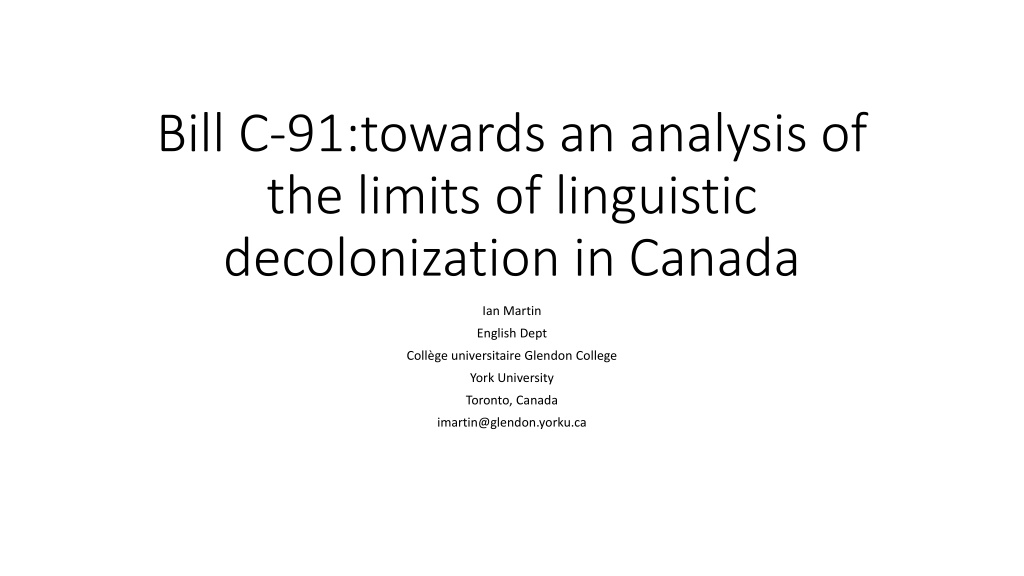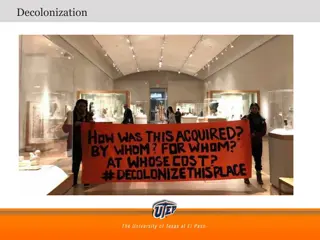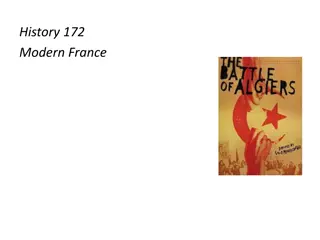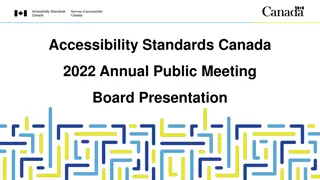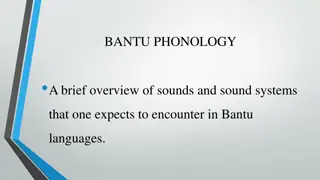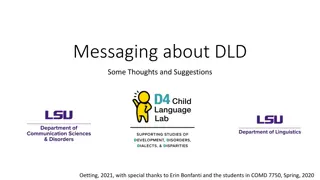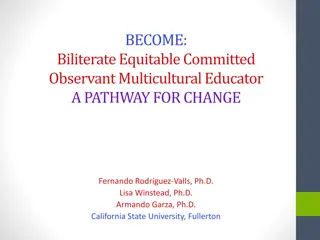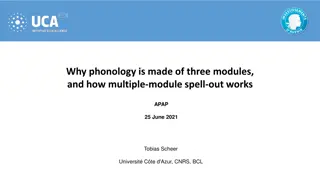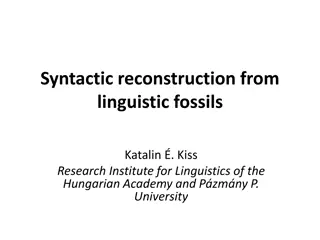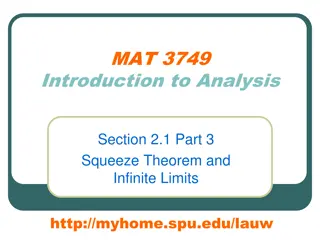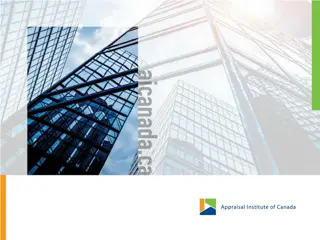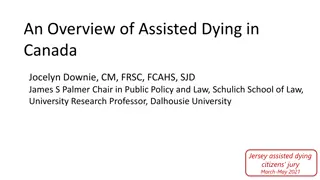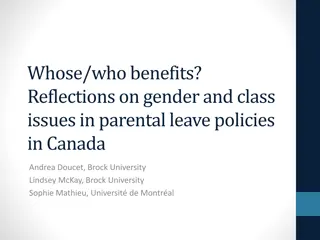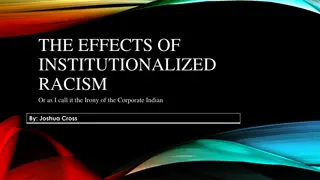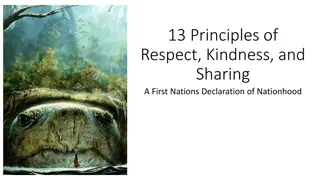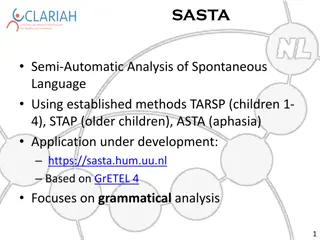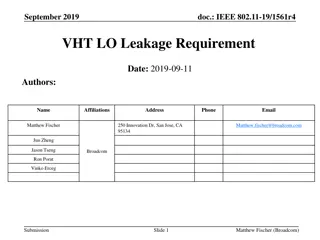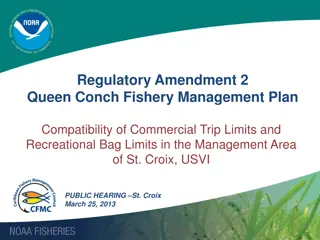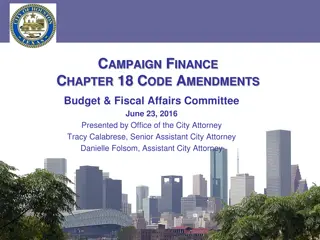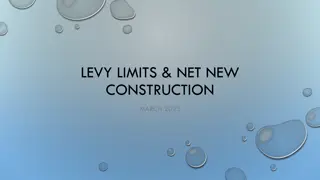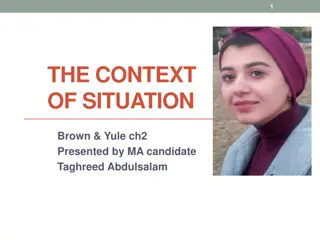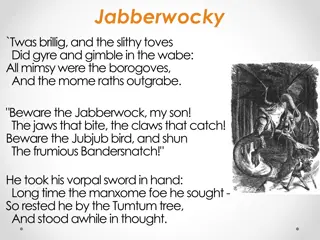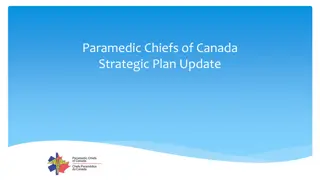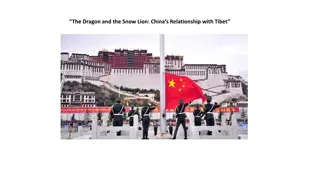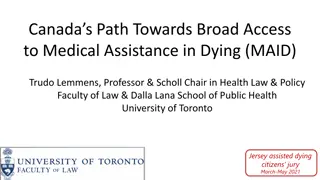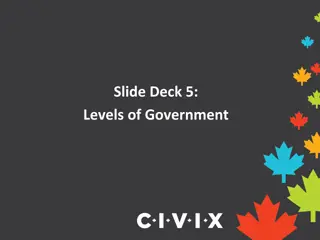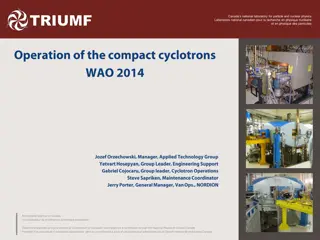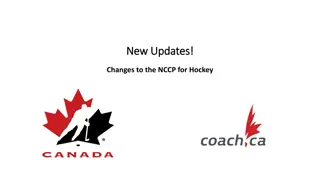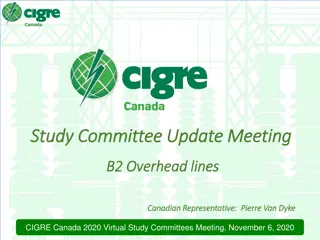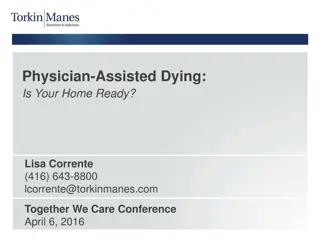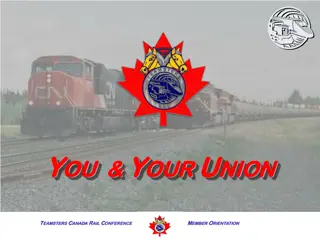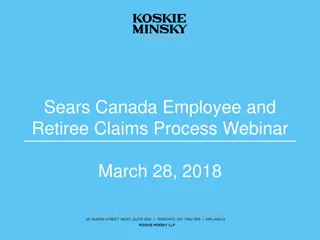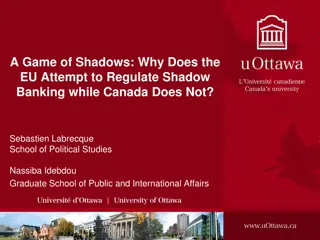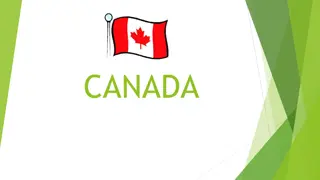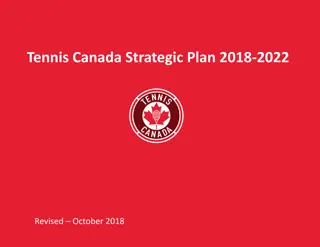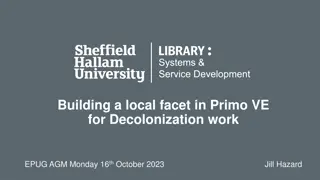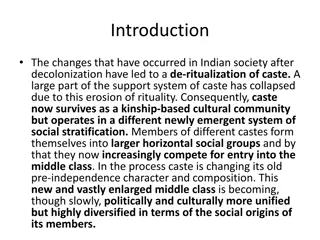Limits of Linguistic Decolonization in Canada: An Analysis
This analysis delves into the complexities of linguistic decolonization in Canada, exploring the historical encounters between Indigenous peoples and Europeans. The narrative emphasizes the need to acknowledge both the peaceful coexistence and the devastating impacts of colonialism on Indigenous communities. Drawing on personal experiences and historical insights, the author highlights the ongoing repercussions of colonial ideologies and the challenges in addressing systemic racism and societal inequalities.
- Linguistic decolonization
- Indigenous history
- Colonialism impact
- Canadian identity
- Historical narratives
Download Presentation

Please find below an Image/Link to download the presentation.
The content on the website is provided AS IS for your information and personal use only. It may not be sold, licensed, or shared on other websites without obtaining consent from the author. Download presentation by click this link. If you encounter any issues during the download, it is possible that the publisher has removed the file from their server.
E N D
Presentation Transcript
Bill C-91:towards an analysis of the limits of linguistic decolonization in Canada Ian Martin English Dept Coll ge universitaire Glendon College York University Toronto, Canada imartin@glendon.yorku.ca
Preliminary #1 A different land acknowledgement is possible. Not every encounter between peoples in history need be colonial or genocidal; what became Southern Ontario, for instance, exhibited 1000 years of peace through mutually beneficial language and culture contact between the Michii Saagig Anishinaabeg/ the Mississaugas, the earliest occupants of this land, and a people who asked the Mississaugas permission to settle here around 600 AD the Eyaawaad / Wendat. For a millennium, the two nations lived complementary lives until the Europeans arrived, bringing diseases, competition over resources and trade, war, religion and dispersal of one of the nations, the Wendat. All this is known through recently published oral history by a Mississauga Elder/scholar. So, acknowledging that this land, at different times, has seen great Indigenous peace and disastrous colonial war on this land is part of coming to grips with our topic today.
Preliminary #2 My own relationship to this question We need to engage with how our lives have been shaped by colonialism s violence and unspeakable suffering that was inflicted on people by other people who spoke colonial languages. We should not be tempted to think that these days are over and that now everyone agrees that taking away people s land and resources without their informed prior consent is wrong but that would ignore the fact that the consequences of colonialism are nothing short of the world that we live in with the social disadvantages which colonialism created, upheld by the Doctrine of Discovery, an imperial ideology, and colonial ideologies about land and law and language, fuelled by a systemic racism which has greatly profited the colonizers and therefore which underpins the Canadian State and, may I say, severely compromises the honour of the Crown in Canada, and therefore harms all of us.
My own knowledge of colonialism My knowledge of colonialism comes from an eye-opening experience I had as an Ontario civil servant Assistant Language Training Officer in the Ministry of Citizenship. My responsibility was to oversee policy for all adult language education in the province second-language learning for immigrants, French programs for Franco-Ontarians, and all adult education for Indigenous Peoples in the province. I was surprised at the last responsibility; as a middle-class son of one of Canada s leading children s educators, and having attended the best private school in Toronto, I had been taught that Indians had all faded away after they helped defend Canada from American attack in the War of 1812, and that we wouldn t have an independent country without them, and that we should be grateful for their sacrifice. Period. Nothing much about them since 1812 in the history books. Then my first week on the job and I am assigned to spend a month in Anishinaabe-Aski Nation (Grand Council Treaty # 9) to find out in each community what its adult education needs would be for the upcoming year. I was given a plane and a pilot and a month. Let s just say that I came out of that month a different person than when I went in. That different person and the person giving this talk are the same.
Preliminary #3: Prof. Lesley Marcom s TEDx talk at Queen s Her talk is a succinct synopsis from an Indigenous linguist and activist both at the university and in the Kingston community. I d like to draw your attention to three points which Prof. Marcom makes: 1. There is no reconciliation without the survivance of Indigenous languages. Here, the idea of survivance which I understand to have been first used by Gerald Vizenor in his 1994 book Manifest Manners implies an active sense of presence , stories which are a renunciation of dominance, tragedy, victimry Prof. Marcom strongly embodies this! 2. We need policy with funding. And it has to work in cities, since 70% of Indigenous people live off-reserve. 3. We need support people wanting to learn. Settler allies. Space to carry out activities.
Preliminary #3: Support, allyship,and the decolonization path Walking the decolonizing path is FROM >>> [various degrees of closedness] >>>TO [various degrees of openness] Unaware of colonial complicity >> * emergent awareness Aware but personally disconnected >> personally connected Connected but without taking responsibility >>** connected and responsible Responsible but passive >> responsible and active Active but unengaged, alone >> ***active and engaged with others Engaged but sectionally >> engaged intersectionally, holistically * here, something extra-ordinary happens. Perhaps you take a course which includes decolonization and indigenization. Or perhaps Tom King gets into your head with one of his stories (or the new film!) and whatever else you may do cry over it, retell it, forget it you can no longer say that you didn t hear it.
What are we up against on the path? the wind is not at our back! It s blowing right into our faces (and it s been blowing for 500 years or so) 1. the whole European nation-state + imperial scheme in which siempre la lingua es la compa era del imperio and the King s English is imposed on all vernaculars and minorities. Monolingualism reigns - literally! 2. England learned to be a violent colonial power at home . The idea of Britishness came with a strong quasi-racial antipathy to Celtic peoples and Catholics. Ask any Irish person. <hint: be prepared for a long conversation!> 3. There is a cast of mind, an epistemological [how do we know anything] and ontological [what is the essence of things?] framework that English Protestant modernity developed around land and language. Let me introduce you to Mr. Locke. (he actually met some Indigenous people Penobscots and got nervous when he discovered that they didn t have a word in their language for a thousand .)
A word about Language. Locke, as seen by Charles Taylor The colonial view of language was based on notions of the superiority of European civilization and language as opposed to non-European. But it was also grounded in a very limited notion of what Charles Taylor calls the human linguistic capacity . The idea of language as merely a representational system for ideas Locke, Hobbes and Condillac s cognitive-utilitarian view of language synchronizes with Locke s view of the proper use of land (to work it so that profit can be derived from it). The view goes like this: in the mind, there are ideas , bits of representation of reality. Knowledge consists in having the representation square with reality, but we need a responsible procedure to do so, and language gives us the key. Words allow us to combine ideas into a responsible picture. Language allows us to classify bits of reality into synthetic wholes rather than be limited to particulars. Abstract = good!
Lockes liberal ideology of language Language is an instrument of transmission of ideas among individuals; as an instrument, its purpose is not to protect one s linguistic or cultural identity, but to overcome obstacles to achieving successful linguistic interactions which may aid in gaining rights, freedoms or economic opportunities. Questions of marginalization or oppression or loss of intergenerational transmission of culture from one s parents are absent in a Lockean frame of mind, since effectively carrying out the communicative function of language is paramount, and the common, dominant language is the most efficient, and the state should not produce policies which impede citizens access to the common language. (hint: it s E____sh). State monolingualism is the most logical and beneficial for Individual Freedom.
Lockean views on land in Ireland and the Americas a productive liberal order is required! We have seen that Irish and Scots had been driven off their land for not exploiting it sufficiently and the colonization of Ireland was justified by the assertion that the Irish would never, to the end of the world, build houses or improve the land as it ought to be (Sir John Davies, who oversaw the colonization of Ireland) The idea was crystallized in C17 political thinker John Locke, who held that ownership of land belonged only to those who improved its productivity. Indigenous land was seen by the early settlers as being wasted, and so it was virtuous to seize Aboriginal land if, by so doing, the land would be rendered more productive. (TRC Report, vol. 1, p. 18) From a Lockean perspective, the English were duty-bound to carry out a civilizing mission, both in Ireland and in the Americas.
The Liberal Order Framework (2000) Prof. Ian McKay (Wilson Chair of Canadian History, McMaster) McKay s thesis: the category Canada should henceforth denote a historically specific project of rule, rather than either an essence we must defend or an empty homogeneous space we must possess. Canada-as-project can be analyzed through the study of the implantation and expansion over a heterogeneous terrain of a certain politico-economic logic to wit, liberalism. (p. 621) - Its prior epistemological and ontological status to the individual it is the individual who truly exists, in a way society or community do not..but the individual is not to be confused with actual living beings excluded from the vote, by mid-Victorian liberals were women, non-owners of property, other races, unassimilated Amerindians.
McKay on Mid-Victorian liberalism and Indigenous peoples - Indigenous peoples conceptions of property, politics and the individual were scandalously~ not derived from the universe of Locke (and, for being pre-liberal and pre-modern and non-capitalist and non-white, they were to be despised) The trancontinental project of rule, though, required that these Indigenous alternative logics be subordinated to the fulfilment of liberal norms, otherwise the Canadian project would be seen as contingent and its claimed sovereignty insubstantial, and so it was perhaps in the residential schools that the full utopianism of a vanguard liberalism came to the fore, for within these Christian/liberal manufactories of individuals, pre-eminent laboratories of liberalism, First Nations children were forced to be free , in the very peculiar liberal sense of free , even at the cost of their lives. (McKay, p. 640)
There was another European view of language Charles Taylor holds up, against Locke s designative and individualistic view of language, the frameworks of Johann Herder and Wilhem von Humboldt, whose view of language he terms constituitive. In this view, language is seen as constituitive of a situated form of life and understands it through what we would call today an ecological lens, in which its onto-epistemology would be unified and relational, connecting people (and peoples) to places and ecosystem services which support ecological flourishing forms of life in their particular environmental circumstances. It is this view, Taylor asserts, which gets us closer to the full shape of the human linguistic capacity. (Taylor, 2016). HHH view was aware that languages are not just a means of saying the same thing as can be said in another language. The language of a people is developed from their distinct encounters with the world .> This view, rather than Locke s, can be enriched into a view of language as essential to the full shape of sustainable human flourishing. Such an example, comes from a profoundly brilliant collective creation by the Okanagan Syilx Nation
Syilx Okanagan Language Declaration 2018 language and a vision of the good life The Declaration, signed by all the Syilx Okanagan Nation, contains 20 articles. Here are a few: The Creator stood us, nsyilxcen speaking people, up here as keepers of our territory, lands, water and resources for the good of all for all time. Our nsylixcen language is our knowledge of the land, water and the t mixw. The laws related to our territory, lands, water and resources are held in our nsyilxcen language. Our high language words have their origin in captikwl and are foundational to our philosophical, ethical, and legal text. Nsyilxcen is the collective force that connects and unifies the people with all life
More Syilx Okanagan Language Declaration articles: Our nsyilxcen language contains knowledge of our spiritual values and practices as expressed in words and used in our ceremonies to instruct and heal ourselves, our families, our communities, our lands and our water. Our nsyilxcen language will always remind us of these relationships and connections through both our extended kinship and community ties and our associated political kinship structures. Our nsyilxcen language contains specific words and phrases that provide guidance and instructions on our protocols that govern our peaceful co-existence with other Salishan nations and how we carry on our governance responsibilities within our territory. Conclusion: the decolonizing path includes recognizing that such a declaration is deeply civilizational, it comes from knowledge keepers that have been thinking about these issues for 1000 years or more. It s not absolutely necessary that you, by contrast, take some time embrace the possibility that mainstream North American civilization is, by contrast, a suicide-machine, but it could help.
So, We need policy and funding: the story of the federal Bill C-91 passed into law in June 2019. and we re still waiting for it to take effect, but it has to on October 1st, 2020. Spoiler alert: the Bill was supposed to answer Prof. Morcom and many others call for policy with teeth, and several Calls to Action from the Truth and Reconciliation Commission, but it fell short of expectations but Murray Sinclair, the Chief Commissioner of the TRC Commission, and now an Independent Senator and sponsor of the Bill in the Senate, had to make a very difficult decision on a Thursday evening in June, 2019, the last day before the Senate had to rise for the summer, but he was able to identify the one thing which the Bill did to move Canada forward on the path to linguistic decolonization
Now, we are in the room. Senator Murray Sinclair, at the end of the final session of the Senate when the Senate, after having all its amendments, including the all-important Inuit amendment, rejected by the House, was faced with the choice of (a) no Indigenous Languages Bill at all or (b) an Indigenous Languages Bill as the government wanted without significant amendments, voted as follows: The Senate does not insist on its Amendments . The Bill, C-91, received Royal Assent the next day, June 21, 2019.
The native peoples simply dont fit how disordered is Canada s linguistic house and how unwilling Canadians are in general to tidy up the mess Ron Wardaugh 1983 Only by recognizing how language policies operate to embed and reinscribe the racial hierarchies at the heart of Canada s ongoing national project can we begin to decolonize the exclusion of indigenous languages, cultures and peoples in Canada. Eve Haque and Donna Patrick 2015 It s The Room where Canada s language rights are decided, where inclusions and exclusions are made
2019 50 years of Official Language policy AND 152 years of state-supported erasure of Indigenous languages. - Long history of LP in Canada > hierarchy of belonging E. Haque with Settler languages and civilization deemed superior to Indigenous civilizations. 150 years of state-supported linguistic erasure of ILs. - LP in the 1960s and 1970s: Bi-Bi Commission, OLA 1969, Bill 101 etc.: an entente between two settler groups which theorized the country as fundamentally about duality , with French, previously endangered, able to stabilize on its majority territory (using territorial principle at provincial level), plus federal support and constitutional guarantees for flourishing Official Language Minority communities right to education. - WE KNOW HOW TO SUPPORT THREATENED MINORITY LANGUAGES! Constitution Act 1982 s.23 constitutionalized in the Charter official languages and minority language-in-education rights in provinces and territories. - But none this LP experience trickled over to support endangered Indigenous language communities.
.until Truth and Reconciliation Commission 2009-2015, Idle No More Movement 2012-13 and beyond with its links to defending the land against extractive exploitation, and the 2008 UN Declaration on the Rights of Indigenous Peoples, and Canada s eventual tentative adoption of its principles. (but Bill C-262 died this summer!) Truth and Reconciliation Commission, Idle No More, UNDRIP destabilize long- held FR-EN bilingualism- only paradigm: but can Indigenous people and languages actually come into The Room? 13 UNDRIP Rights cited by GC Wilton Littlechild in his brief to House Standing Committee on Heritage as related to language: 1. Indigenous peoples have the right to full enjoyment of all human rights and fundamental freedoms 3. Indigenous peoples have the right of self-determination. By virtue of that right they freely determine their political status and freely pursue their economic, social and cultural development.
5. Indigenous peoples have the right to maintain and strengthen their distinct political, legal, economic, social and cultural institutions, while retaining their right to participate fully, if they so choose, in the political, economic, social and cultural life of the State. UNDRIP Rights related to language (2) 8. Indigenous peoples and individuals have the right not to be subjected to forced assimilation or destruction of their culture . 11. Indigenous peoples have the right to practice and revitalize their cultural traditions and customs the right to maintain, protect and develop the past, present and future manifestations of their cultures
13. (1) Indigenous peoples have the right to revitalize, use, develop and transmit to future generations their histories, languages, oral traditions, philosophies, writing systems and literatures (2) States shall take effective measures to ensure that this right is protected UNDRIP Rights related to language (3) 14. (1) Indigenous peoples have the right to establish and control their educational systems and institutions providing education in their own languages, in a manner appropriate to their cultural methods of teaching and learning. (2) Indigenous individuals, particularly children, have the right to all levels and forms of education of the State without discrimination. (3) States shall, in conjunction with Indigenous peoples, take effective measures, in order for Indigenous individuals, particularly children, including those living outside their communities, to have access, when possible to an education in their own culture and provided in their own language.
15. .rights to the dignity and diversity of their cultures, traditions, histories and aspirations, which shall be appropriately reflected in education UNDRIP Rights related to language (4) 16. right to establish their own media in their own languages 31 right to maintain, control, protect and develop their cultural heritage, traditional knowledge and traditional cultural expressions, as well as the manifestations of their sciences, technologies, and cultures 37 right to the recognition, observance and enforcement of treaties, agreements and other constructive arrangements concluded with States or their successors, and to have States honour and respect such treaties, agreements or other constructive arrangements.
(1) The federal actions constituted cultural genocide : to eliminate Indigenous peoples as distinct peoples; many children died; it sought to erase knowledge and use of mother tongues. The policy also denied children the opportunity to find answers to the four important questions. Who am I? where have I been? Where am I going? What is my purpose? <Murray Sinclair, now Senator. Chief Commissioner. The Final Report of the TRC Commission of Canada on Indian Residential Schools December 2015 . (2) CALL TO ACTION 43 We call upon federal, provincial, territorial, and municipal governments to fully adopt and implement UNDRIP as the framework for reconciliation. CALL TO ACTION 44 We call upon the Government of Canada to develop a national action plan to achieve the goals of UNDRIP
CALL TO ACTION # 13: We call upon the federal government to acknowledge that Aboriginal rights include Aboriginal language rights. This Call refers to the constitutional recognition of aboriginal rights/inherent rights, treaties and treaty rights, stated in s.35 of the Constitution Act, 1982: 35(1) The existing aboriginal and treaty rights of the aboriginal people in Canada are hereby recognized and affirmed. (3) For greater certainty, in subsection (1), treaty rights includes rights that now exist by way of land claims agreements or may be so acquired. Three core TRC CALLS TO ACTION on Indigenous language (13, 14 and 15)
s.35 rights: inherent and Treaty rights, under British Crown protection; but with 1867,a new harsh colonialism - three constitutional conferences in the 1980s couldn t find a federal-provincial-Indigenous consensus on s.35 rights: an empty box (provinces) or a full box (Indigenous leaders)? -these existing rights prior to 1982 are (a) Inherent Rights (prior to Contact), and (b) Treaty rights (post-Contact and pre- 1982) between Indigenous Nations and the Crown. These can be assumed to have included rights to language, culture, education, health, citizenship, hunting, fishing, trapping and gathering, and powers of self-determination. such rights were recognized by the British Crown in the 1763 Royal Proclamation and in 1764 in the Niagara Treaty, and in subsequent pre-Confederation peace and friendship treaties, which shielded somewhat Indigenous Peoples from the British North American colonies pressure to seize Indigenous lands. with the creation of Canada in 1867 by four colonies confederating, with a diminishment of Crown protection, Indigenous Peoples faced a new nation-to-nation relationship, defined by the 1876 Indian Act, a quintessential colonial act with genocidal intent and outcomes.
Under the British North America Act of 1867 (now: Constiution Act, 1867), section 91(24) gave exclusive jurisdiction over Exclusive Federal jurisdiction over Indians, , but Indians and lands reserved for Indians to the federal government. BUT very early, following 1867, the coming into existence of provincial crowns and provincial powers eroded the federal government s ability to prevent dispossession of Indian lands by colonial governments colonies which are now called PROVINCES a significant source of First Nations misery J.Borrows 2017.
Today, there is a need to uphold Indigenous jurisdiction and rights, after 152 years of internal colonializing pressures of provinces (and an absent Crown) It is important to assert constitutional guarantees of s.91(24) of the 1867 act (federal jurisdiction) and of s.35(1) of 1982 (recognizing and affirming Aboriginal rights) AGAINST provincial pressures upon Indigenous jurisdiction And AGAINST federal complicity in off-loading s.91(24) responsibilities onto provinces often aided and abetted by the Supreme Court. And stopping the colonial (=provincial) dispossession of First Nations lands to benefit extractive industries (constitutionally under provincial jurisdiction). This is especially pertinent with respect to Indigenous EDUCATION off-reserve (whose responsibility? Fed-prov-Indigenous jurisdictional overlap?) And it is key to understanding the reception of many Indigenous people to C-91, the Indigenous Languages Act
At an AGM of the AFN in Ottawa, Trudeau makes a surprise announcement of his government s intention to respond to three TRC Calls to Action: #13 (gov t acknowledge that Aboriginal rights include Aboriginal language rights) #14 (gov t enact an Aboriginal Languages Act) and #15 (gov t appoint an Aboriginal Languages Commissioner) Back to the narrative: The Dec 2016 announcement by PM He receives a standing ovation. This announcement was made just 3 weeks after the Glendon Declaration advocating the same three Calls had been taken to Ottawa and discussed with INAC officials.
(1) Glendon TRC Declaration focus on 13, 14 and 15 - POSITIVE RIGHTS (David Leitch, Lorena Fontaine) - FOLLOW THE GUIDE OF THE 2005 TASK FORCE (Amos Key Jr. Commissioner) Between TRC Dec 2015 and PM announcement Dec 2016: two complementary conferences - HAVE THREE COMMISSIONERS, NOT ONE (2) First Peoples Cultural Council (B.C.) [Galley, V. et al] - strong focus on education (There is a Call to Action #10 We call on the federal government to draft new Aboriginal education legislation (iv) protecting the right to Aboriginal languages, including the teaching of Aboriginal languages as credit courses. )
1) Aboriginal languages are a fundamental and valued element of Canadian culture and society, and there is an urgency to preserve them. 2) Aboriginal language rights are reinforced by the Treaties Call to Action 14 - TRC stipulates 5 principles 3) The federal government has a responsibility to provide sufficient funds for Aboriginal language revitalization and preservation 4) The preservation, revitalization and strengthening of Aboriginal languages is best managed by Aboriginal people and communities. 5) Funding for Aboriginal language initiatives must reflect the diversity of Aboriginal languages. My personal assessment: 5(strong) 1(weak) 2 [somewhat weak]
We call on the federal government to appoint, in consultation with Aboriginal groups, an Aboriginal Languages Commissioner. The Commissioner should help promote Aboriginal languages and report on the adequacy of federal funding of Aboriginal-language initiatives Call to Action 15 Aboriginal Languages Commissioner Our (world-famous) office of Official Languages Commissioner is an Officer of Parliament, has a staff of some 200, with offices across Canada, can investigate complaints and initiate legal actions for non-compliance with the Official Languages Act or the Constitutional protection for official language minorities, reports annually on compliance. The ALC mandate is very weak compared to the OLC.
-Early engagement sessions led by Heritage and by NIOs MAIN THEMES: - importance of Indigenous worldviews embodied in languages - enforceablelanguage rights UN Declaration, TRC Calls to Action, Royal Commission (RCAP) 1996, 2005 Task Force Report on Language - Indigenous control (the question of the Crown-Indigenous relationship) - role of supporting entities (infrastructure, capacity questions) - mandate of Commissioner (or Commissioners) Co Co- -development development process process - -2017 2017 Led by the Department of Canadian Heritage, in co-development dialogue, principally with the National Indigenous Organizations: AFN Association of First Nations . (Perry Bellegarde, Grand Chief) MNC Metis Nation of Canada (Clement Chartier, President) ITK Inuit Tapiriit Kanatami (Natan Obed, President)
- recognition of importance of language to land, culture, traditional knowledge, worldview, participation in the economy - acknowledge need to redress harm caused by colonization - affirm TRC Calls to Action, UNDRIP rights, other key human rights instruments - affirm FN jurisdiction over FN languages AFN Principles Dec 2017 - affirm enforceable individual and collective rights - articulate specific federal obligations, duties and authorities - establish institutions to advance FN objectives and rights
Co- development working group principles 2017 - DISTINCTION-BASED LEGISLATION NOT A PAN- ABORIGINAL APPROACH - LANGUAGES AS CORE TO INDIGENOUS IDENTITIES, SPIRITUALITY, RELATIONSHIP TO LAND, WORLDVIEW AND CULTURE - ACKNOWLEDGE HARMS OF PAST GOVERNMENT PRACTICES - ACKNOWLEDGE THAT INDIGENOUS LANGUAGE RIGHTS ARE INHERENT ABORIGINAL AND TREATY RIGHTS - INDIGENOUS-CONTROLLED EDUCATION SYSTEMS, NO MATTER WHERE THEY RESIDE (I.E. ON AND OFF RESERVE) - FUNDING TO SUPPORT ADEQUATE REGIONAL INSTITUTIONAL INFRASTRUCTURE TO SUPPORT LOCAL EFFORTS, EG A NATIONAL INSTITUTION WITH REGIONAL HUBS
Focus on 6 questions posed by DOCH: - practical implications of legislating a language right? - create or enhance local and regional language institutions? - could a national language institution be helpful? - what role for the Commissioner? - how best to preserve, promote, revitalize Indigenous languages? - how should funding be distributed? 2018 Intensive engagement sessions (DOCH) <the questions seemed unfocussed, bureaucratic, out of touch with the principles developing on the Indigenous side and (dangerously) no sign of the DOCH acting as lead ministry; it appeared to be acting alone>
Why the gap between DOCH and NOIs? #1 DOCH itself should not be the lead ministry The preservation of Aboriginal languages should not be a part of the Canadian Department of Heritage. Such an approach does little credit to Canada s legal and moral duties towards Aboriginal peoples, and does little to make reparations for the forced assimilation of Aboriginal people in residential schools. TRC v.5 The Legacy p. 117.
Despite the governments original commitment to involve INAC (which in 2018 was split into CIRNA [Crown-Indigenous Relations and Northern Affairs] and ISC [Indigenous Services Canada]), with DOCH being the lead ministry , there was no public evidence of CIRNA or ISC involvement in the development of C-91. This meant that two key themes are absent: (a) nation-to-nation relations and the potential role of language in Indigenous Nation re/building (b) long-term, stable funding for education in Indigenous languages as languages of instruction. Why the gap between DOCH and NOIs? #2 absence of CIRNA and ISC
The Indigenous Rights Framework: was announced in Feb 2018 to shape Indigenous rights to be recognized within nation-to-nation / Crown-Indigenous relationships. It was to represent Canada s notion of decolonization . Why the gap between DOCH and Indigenous co-developers ? #3 A parallel framework process was in the works BUT it rested on the federal government s 2017 Ten Principles respecting the GoC s relationship with Indigenous peoples, seen as problematic, wanting to incorporate Indigenous peoples into pre-existing Canadian legal orders, extends no new affirmation of rights, and is a potential threat to Indigenous rights and title. [King and Pasternak, June 5, 2018. Canada s Emerging Indigenous Rights Framework: A Critical Analysis. Yellowhead Institute, Ryerson University.
- related to a 2011-12 Governance Toolkit written by Jody Wilson-Raybold and her husband for BC First Nations: advocated that FNs amalgamate into larger units (nations) and develop constitutions to manage reserve-based affairs, develop strategic plans, and negotiate MOUs with the federal government. Goal: post-Indian Act reserve-based self- governments delivering municipal-like services (often through a tri-partite model, involving provinces) with a fiscal mechanism (10-year block grants) to support the new nation . [Indigenous language and education seen to be among the responsibilities the feds are willing to off- load to Indigenous groups negotiating a self- government agreement]. A bureaucratic federal plan: Re- constituting nations under the <new in 2018> CIRNA ministry.
But this Rights Framework plan had to be withdrawn Sept 2018 in the face of Indigenous opposition. The Framework was rejected at a General Assembly of the AFN; it was called insulting and the AFN asked for the file to be handed over from the CIRNA ministry (Carolyn Bennett) to Justice (Judy Wilson-Raybould). The Cabinet shelved the Rights Framework, but decided to move forward with the Indigenous language bill C-91 (and the child welfare bill C- 92), which had been crafted under the same rights framework vision.
C-91 IS INTRODUCED Feb 9, 2019 and so a bill which was to have been introduced as a companion to the Act to Establish Indigenous rights, Recognition and Implementation Framework and which was cut from the same ideological cloth as the paused Framework seen as insulting by the Chiefs Council of the AFN was introduced into the House of Commons on February 9, 2019 by a new Minister of Canadian Heritage, Pablo Rodriguez and responded to in Cree by MP Romeo Saganash, whose private members Bill C-262 to harmonize Canadian Law with the United Nations Declaration, was still a possible companion.
- two of the NIO leaders, Perry Bellegarde (AFN) and Cl ment Chartier of the MNC praised the Bill. - Natan Obed, ITK President, panned it as yet another legislative initiative developed behind closed doors by a colonial system and then imposed on the Inuit Initial reception of C-91: mixed - Indigenous thought-leaders not impressed. a opportunity lost , disappointing , lip service , a good start, but needs more teeth . Pam Palmeter (Ryerson U. Indigenous Governance) made the connection with the Rights Recognition framework: bountiful in flowery wording, but empty on substantive rights and appears to utilize the same federally- controlled legislative framework concept for rights definition, limitation and scoping.
The Minister of Canadian Heritage and Multiculturalism, in order to provide adequate long-term funding to reclaim, revitalize, maintain, and strengthen their languages must consult with a variety of Indigenous governing bodies and organizations and may cooperate with these Indigenous entities and with provinces/territories in order to enter into arrangements or agreements in order to establish a framework and measures to support efforts of Indigenous governing bodies, thereby affirming that Indigenous rights as set out in s.35 of the Constitution include [unspecified] Indigenous language rights. (20 CLAUSES) The Bill itself a summary of C-91 The Minister will also appoint, following consultations with Indigenous peoples, an Indigenous Languages Commissioner, responsible to the Minister, with a mandate to help promote Indigenous languages, support the efforts, review complaints, promote public awareness, undertake research including community assessments and report annually to the Minister (copied to Parliament) on progress and sufficiency of funding to achieve the aims of the Act. (30 CLAUSES)
- Text of the act original, then passed with amendments Discussions in the House House Standing Committee on Canadian Heritage witnesses oral statements and written briefs (21) Discussions in the Senate Senate Standing Committee on Aboriginal Affairs witnesses oral statements and written briefs Data on this act - a feast of LP documentation Media reports, independent analyses, documents from NIOs, from Heritage Ministry. Statements from proponents in House and Senate. Statements from opposition critics.
Witsuwiten Language and Culture Society My focus: the 21 written briefs to the House Standing Committee on Heritage (1) Saskatchewan Indigenous Cultural Centre Inuit Tapiriit Kanatami First Peoples Cultural Council First Nations Summit First Nations Confederacy of Cultural Education Centres Assembly of First Nations Chiefs of Ontario Rebecca Major, Tejas Pandya, Emmanuel Richez (U of Windsor) Amos Key, Jr
Canadian Bar Association Matawa First Nations Bridget Fanta (Fort Vermillion teacher) Briefs to House Standing Committee on Heritage (2) Wilton Littlechild Ellen Gabriel (Kahneseta:ke) Glendon College, York University Ktunaxa Nation Council Onowa McIvor (University of Victoria) David Leitch (Lawyer) National Association of Friendship Centres
These are some of the illustrious people who spoke out on C-91 and who are now in The Room
RELATIONSHIP ISSUES problematic 14 (including 5 opposed to PROVINCIAL AGREEMENTS) COMMISSIONER s mandate unclear - 10 RIGHTS weak and unspecified -14 Main themes raised in 21 briefs to House Standing Committee on Heritage Feb- Mar 2019 NATIONAL PURPOSES of Bill and FUNDING FLOWS unclear 8 CO-DEVELOPMENT PROCESS weak -8 ORGANIZATION/INFRASTRUCTURE 7 DEFINITIONS of Indigenous governing body unclear 7 (Who are the Indigenous here?) INEQUALITY WITH OFFICIAL LANGAUGE PROVISIONS - 6 OFFICIAL STATUS 6 PAN-ABORIGINAL APPROACH wrong 4 MINISTER S POWERS 5
My thesis: Each theme raised points to a limit to full linguistic decolonization. The two main themes raised were: RELATIONSHIP ISSUES - failure to recognize Indigenous self-government, inherent rights, treaties, excessive attention federal relationship to provinces and territories ahead of Crown- Indigenous relationship, no mention of duty to consult, free prior and informed consent, or federal fiduciary duties. Fine language in preamble, weak language in operative sections of Bill. RIGHTS: no new rights created or specified; no mention of specific UNDRIP rights (esp. 14.1 on Indigenous schooling in own language) or respect for International human rights (to compensate for Canada s insipid constitutional language on Indigenous rights, and despite much government fanfare about fully implementing UNDRIP AND none of the rights set out are justiciable [unlike s. 23 minority language rights for Official Language Minorities]
